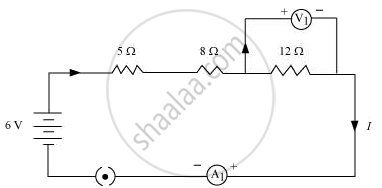Advertisements
Advertisements
Question
Redraw the circuit of question 1, putting in an ammeter to measure the current through the resistors and a voltmeter to measure the potential difference across the 12 Ω resistors. What would be the readings in the ammeter and the voltmeter?
Solution
An ammeter should be connected in the circuit in series with the resistors. To measure the potential difference across the resistor it should be connected in parallel, as shown in the following figure.

The resistances are connected in series.
Ohm’s law can be used to obtain the readings of ammeter and voltmeter.
According to Ohm’s law,
V = IR,
Where,
Potential difference, V = 6 V
Current flowing through the circuit/resistors = I
Resistance of the circuit, R = 5 + 8 + 12 = 25Ω
I = `V/R`
= `6/25`
= 0.24 A
Potential difference across 12 Ω resistor = V1
Current flowing through the 12 Ω resistor, I = 0.24 A
Therefore, using Ohm’s law, we obtain
V1 = IR
= 0.24 × 12
= 2.88 V
Therefore, the reading of the ammeter will be 0.24 A.
The reading of the voltmeter will be 2.88 V.
RELATED QUESTIONS
What is a circuit diagram
Tell the odd one out. Give proper explanation.
Two tungsten bulbs of power 50 W and 60 W work on 220 V potential difference. If they are connected in parallel, how much current will flow in the main conductor?
In an electric circuit, a battery and a bulb have been connected and the battery consists of two cells of equal potential difference. If the bulb is not glowing, then which tests will you perform in order to find out the reason for the bulb not glowing?
Explain the following:
Open circuit
What is open circuit?
How much is the potential difference between live and neutral wires?
_____ has a thin metallic filament that melts and breaks the connection when the circuit is overheated.
In a simple circuit, why does the bulb glow when you close the switch?
Explain about domestic electric circuits. (circuit diagram not required)
Instead of metal wires, a jute string can be used to make a circuit.
______ is a kind of fish which is able to produce an electric current.
In a circuit, if the key is in open (off) condition, then electricity will not flow.
Draw a circuit diagram of an electric circuit containing a cell, a key, an ammeter, a resistor of 2Ω in series with a combination of two resistors (4Ω each) in parallel and a voltmeter across the parallel combination. Will the potential difference across the 2Ω resistor be the same as that across the parallel combination of 4Ω resistors? Give reason.
Observe the circuit given:
1. Would any of the bulbs glow when the switch is in the ‘OFF’ position?

2. What will be the order in which the bulbs A, B, and C will glow when the switch is moved to the ‘ON’ position?
Match the following
| 1. | Insulator | a. | Coulomb |
| 2. | Conductor | b. | Electric circuit |
| 3. | Closed path | c. | Copper |
| 4. | Electric charge | d. | Rubber |
Boojho has a cell and a single piece of connecting wire. Without cutting the wire in two, will he be able to make the bulb glow? Explain with the help of a circuit diagram.
